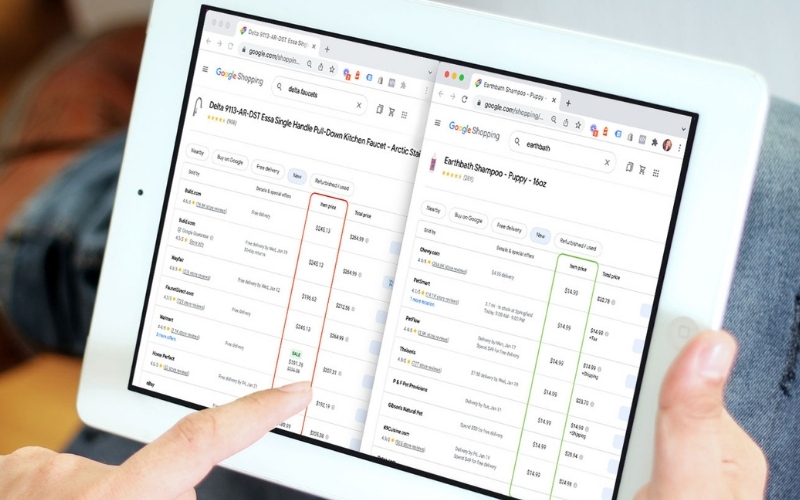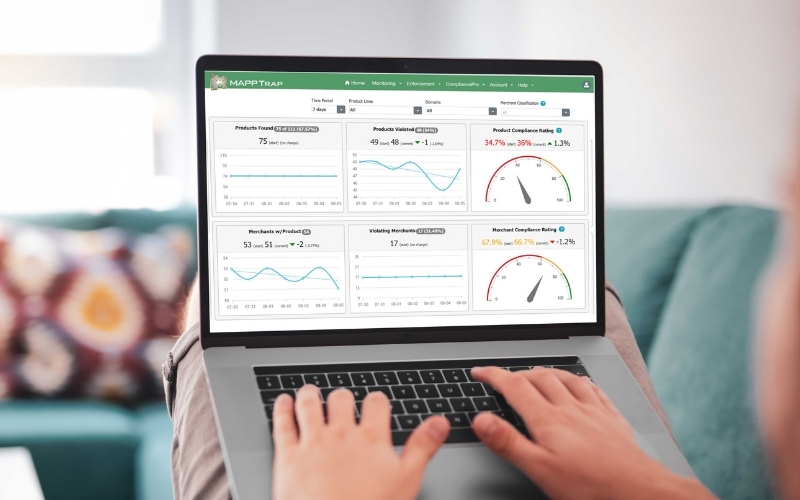E-commerce is a crowded space. By some estimates there are between 12 million and 24 million online sellers worldwide. And because of how easy it is to open an online store and get access to products, more sellers are joining that group every day. Sounds good, right? More sellers means more opportunities for brands to reach consumers who want to buy their products. However, it's not so cut and dry.
It may seem counterintuitive, but the more online retailers there are, the more difficult it is for the 24 million sellers to get shoppers to buy from them. So, what do they do? They discount the products they sell. And while that may seem like fair competition, it can ultimately hurt the retailer, the brand-owner, and the consumer.
To make the most of the highly competitive e-commerce space and maintain the value of their products, manufacturers (we'll refer to them as brands in this guide) have adopted multiple strategies. The most widely adopted of those is minimum advertised price, otherwise known as MAP pricing.
What is MAP Pricing?
MAP is an abbreviation for minimum advertised price. At its core, a MAP pricing policy tells retail partners the minimum price at which they can advertise a given product. Retailers may ultimately sell the product for whatever price they want, but if they also want to continue working with the brand, the sticker price cannot be a lower amount than the MAP price.
MAP pricing is intended to protect all parties in a transaction: the brand, the retailer, and the consumer. By maintaining stable, predictable profit-margins, brands can continue developing high-quality products. That, in-turn, gives retailers a level playing field through which they (either through e-commerce, physical stores, or mail-order catalogs) can sell the products to consumers. If retailers cannot have stable margins, then they pressure the brand to lower the wholesale cost, causing a reduction in quality. If the brand won’t lower the cost, then the retailers stop carrying the products. Either of these two possible consequences can negatively affect consumers by offering less selection and sometimes poorer quality, perhaps even dangerous, products.
A brand establishes its minimum advertised price policy and, through its various sales channels, distributes it to its authorized resellers. Either in policy or internally, the brand determines the consequences of non-compliance. Best practice across many industries is the adoption of a three-strike enforcement policy. That means a retailer gets two warnings prior to being terminated as an account. The brand hires a company like MAPP Trap to do daily price monitoring of e-commerce websites like Amazon, Walmart, eBay, etc., and then send appropriate notices of non-compliance.

What's the Difference Between MAP and MSRP?
Most consumers are familiar with Manufacturers Suggested Retail Price, more commonly known as MSRP. What does MSRP do? It is an arbitrary price set by the brand owner that does two things: First, the MSRP conveys a perception of value. High quality, luxury brands generally have higher MSRPs when compared to similar products. Think of the different MSRPs for watch brands, women’s handbags, or automobiles. The higher the retail pricing, the greater the perceived value. You wouldn’t expect to buy a Rolex watch for the same price as a Timex, right?
MSRPs are also intended to show retailers how much money they can make when selling a product. Since the wholesale cost (the price a retailer pays for a product) is a set price, an MSRP gives a profit target. Retailers can, of course, sell products for more than the MSRP but it sets a baseline profit, even if not always met.
Another pricing acronym is MRP, which stands for minimum retail price. Unlike MAP pricing (which sets a minimum advertised price, an MRP is a price set by a manufacturer that states that a retailer may not sell a product for less. Translated to the e-commerce world, the MAP would be the listing price and the MRP would be the in cart or checkout price. When enforced properly, an MRP is not considered price fixing. However, it is a much more difficult policy to enforce, which is why companies like Apple and Coach maintain their own retail stores and limit how many other retailers are allowed to sell their products.
One final acronym to know is iMAP, which is internet minimum advertised price. IMAP is the minimum advertised price that a retailer can advertise for a product on the internet. The purpose of iMAP is to protect brick-and-mortar stores from being undercut by online retailers.

How to Implement a MAP Pricing Policy
Once a brand has decided to apply a MAP policy to its products, they need to consider several important factors. Here are the most important of these:
-
Which products should fall under the MAP? This is one of the most misunderstood areas. A brand does not have to apply MAP to all of its products. As a unilateral pricing policy, they get to decide. MAPP Trap generally recommends that brands only apply MAP to their new and/or most important products. Since it’s their policy, they can change which products (and what prices) are included whenever they want.
-
What is the MAP pricing and how can they create a formula to keep that consistent? Some brands use MSRP as their MAP. Others will use a slightly lower price than MSRP. Still others may add a fixed percentage to their cost or their wholesale price. MAPP Trap has helped many brands to understand the online value of their products and create appropriate pricing from that. No matter what, having a consistent, repeatable way of determining the MAP price is important.
-
What constitutes a MAP violation? Does it apply to physical stores as well as ecommerce (this is called an iMAP)? Is the offer of free shipping a violation? Can a retailer state, “call or click for price?” or “10% discount applied at checkout?” As a standard rule of thumb, the ‘keep it simple’ concept is best. Monitoring retailers for highly detailed nuances in price can be difficult.
-
What are the penalties for non-compliance? This is a very important decision because suspending customers reduces top-line sales. And even though the purpose of minimum advertised pricing is to protect margins and brand equity, it’s still a hard decision. Some brands make it simple: one strike and you’re out. This means that a single infraction results in account termination. But some companies try to mitigate the loss by giving a couple of warnings before cutting a customer off. They may even try to enforce MAP on the product level, rather than the entire catalog.
After deciding on these areas, the brand should hire an attorney to write the policy. While it’s a common practice to look at the policies of competitors, using them verbatim is a bad idea. Every company is different, so MAP policies should reflect each brand’s reasons for adopting the policy and be a statement of their values and risk tolerances.
Unfortunately, many brands say they have MAP pricing policies but, for a myriad of reasons, never enforce them. Maybe it’s because they don’t want to lose revenue, maybe they’re only saying they have it to satisfy complaining retailers, or maybe it’s because they don’t have the resources needed to monitor ecommerce and enforce the MAP policy effectively. The bottom line here is not to say there is a MAP policy if it’s not going to be enforced. Not only will that result in a loss of credibility, but it also presents some potential legal dangers.
Another nuance that brands frequently don’t consider is enforcement against unknown or unauthorized sellers. A MAP policy is just one arrow in the quiver of brand protection. It should only apply to sellers the brand knows and authorizes to resell their products. Other sellers simply should not be there, so any price is irrelevant. There are other far more effective ways of handling those types of retailers, such as citing the unauthorized use of intellectual property (e.g., copyrights and registered trademarks).

Is MAP Pricing Legal?
Unlike Terms and Conditions (usually signed agreements with wholesale customers) which govern subjects like payment terms, discounts, shipping, use of intellectual property, and warranties, a MAP policy is a unilateral statement made by the brand owner and does not require a signature from the retailer. So long as the policy is enforced properly, it is not considered price fixing and does not violate antitrust laws in the United States or Canada. Unilateral pricing policies are currently illegal in the European Union.
As a policy, MAP is not legally enforceable. In other words, a brand cannot sue a retailer for violating its policy. The brand’s only real option is to suspend or terminate accounts. This can be difficult because in today’s digital age, retailers have the greatest access to inventory in the history of commerce. Therefore, the brands must also use companies like MAPP Trap to help them identify the true entities behind the online stores.
MAP Policy Enforcement Tools
There are thousands of companies that create and sell software to enable e-commerce sales. Most of that software is dedicated to the retail side. Products that assist with inventory, online store creation, and price management make today’s online sellers very streamlined. Price management software, in particular, allows the automated updating of prices. Retailers use these tools to make sure their prices are competitive with other retailers. Unfortunately, the widespread use of these repricing algorithms leads to a fast — and automated — race to the bottom.
Brands that want to effectively enforce MAP policies also have software tools they can adopt. In particular, a tool like MAPP Trap, provides all the necessary aspects of MAP policy enforcement. Those areas include: monitoring products and prices, identifying sellers, and sending policy non-compliance notifications.
MONITORING: The ever-growing population of individually owned online stores, coupled with tens of millions of Amazon, eBay, Walmart and other marketplace sellers, makes price monitoring a very difficult task. It simply cannot be done manually. MAPP Trap has powerful price monitoring software that watches brands’ products across the internet. The software not only looks for codes (UPC, GTIN, SKU, etc.) but it emulates the way consumers search for products and has rigid filters to avoid false positives.
IDENTIFICATION: As previously mentioned, today’s retailers have incredible tools to access inventory. In many cases, online sellers don’t even stock the products they list on their stores. They get product information and images uploaded to their stores, then the products are shipped by third-parties that actually have the inventory. MAPP Trap employs tools to determine not only the identity of these unauthorized sellers, but the sources of the inventory as well. This data is vital in determining if the sellers are actual customers operating under pseudonyms.
MAP ENFORCEMENT: Once a violation has been identified and the contact information for the violating retailer has been determined, contact must be made that tells the violator they are non-compliant. Not only is this a time-consuming task, but keeping track of who has received notices and who has been terminated requires a high-level of organization. MAPP Trap’s policy enforcement tools enable the automated creation, dissemination, and tracking of such notices.

MAP Pricing Case Studies
MAPP Trap has helped hundreds of brands across many industries to not only identify their weaknesses, but to create and administrate MAP policies and Authorized Reseller programs to help safeguard brand equity. Here are a couple of examples.
EARTHWHILE ENDEAVORS
This leading manufacturer of eco-friendly pet shampoos, grooming wipes, and spritzes approached MAPP Trap to help the brand regain control of its ecommerce pricing. MAPP Trap created an extensive market assessment, and then developed, implemented and administered strategies (including MAP and Authorized Reseller Policies) to correct a market that was out of control.
Over the course of nine months the following actions and more were taken:
-
Assisted in the creation of MAP Policy, Reseller Policy and Distributor Agreement
-
Implemented, administered, and tracked multi-step MAP enforcement plan (over 1,500 email notices sent)
-
Issued DMCA takedown notices to unauthorized sellers.
-
Developed special program designed to uncover inventory sources of unknown sellers
-
Held weekly update and strategy sessions with client
-
Advised and implemented strategic changes as required
The results of this combined effort of MAPP Trap and Earthwhile Endeavors were extremely successful.
-
Overall daily violations were reduced by 93%
-
Overall Violating Sellers were reduced by 80%
-
Total online sellers were reduced by 42%
-
Retail Margins increased by over 30% on 8 of 10 top selling products
Rev-A-Shelf
This market leading cabinet and lighting company came to MAPP Trap to help them launch their IMAP policy. Rev-A-Shelf had never established an IMAP program and were starting to get pressure from their merchants to reduce their wholesale prices to deal with sellers racing to the bottom or else they would be forced to stop carrying Rev-A-Shelf products.
MAPP Trap created an extensive market assessment, then developed, implemented and administered strategies (including MAP and Authorized Reseller Policies) to meet the following objectives:
-
Decrease MAPP Violations on Amazon.com
-
Decrease MAPP Violators on Amazon.com
-
Remove unknown and unauthorized sellers on Amazon.com
-
Increase online advertised prices
Within twelve months, the results were impressive:
-
Overall daily MAP violations were reduced by 87%
-
Overall MAP Violating Amazon Sellers reduced by 63%
-
Total Amazon sellers were reduced by 35%
-
Average advertised prices increased of their top seller products increased between 20% - 47%